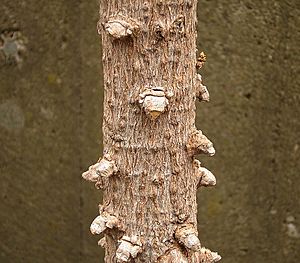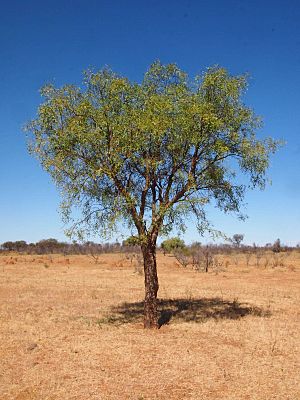Erythrina vespertilio facts for kids
Quick facts for kids Erythrina vespertilio |
|
|---|---|
 |
|
| Scientific classification | |
| Kingdom: | |
| (unranked): | |
| (unranked): | |
| (unranked): | |
| Order: | |
| Family: | |
| Genus: |
Erythrina
|
| Species: |
E. verspertilio
|
| Binomial name | |
| Erythrina vespertilio |
|
The Erythrina vespertilio is a special tree that grows naturally in northern and north-eastern Australia. You might know it by its common names like grey corkwood or bat's wing coral tree. People also call it yulbah or sometimes just "bean tree". In the Western Desert language, it's known as ininti.
This tree is quite unique because its leaves look a lot like a bat's open wings!
Contents
What Does the Bat's Wing Coral Tree Look Like?
This small tree often has a bit of a wild, spreading shape. It usually grows to be about 6 to 10 metres (20 to 33 ft) tall. Its trunk can be around 0.3 m (1.0 ft) wide.
The trunk and branches have thorns, which help protect the tree. The bark is very interesting; it's deeply grooved and feels like cork, with a creamy-grey color.
Leaves of the Bat's Wing Coral Tree
The leaves are usually made up of two or three smaller leaflets. They are about 10 to 15 centimetres (4 to 6 in) long. Each leaflet has a wide, wedge-like shape with three distinct parts, making them look just like a bat's wings! These leaflets are typically 7 to 12 cm (2.8 to 4.7 in) long and 5 to 12 cm (2.0 to 4.7 in) wide.
During the dry season, this tree is deciduous. This means it loses its leaves, just like some trees do in winter.
Flowers and Seeds
The Erythrina vespertilio blooms between August and September. It produces beautiful scarlet to orange-red flowers that look like peas. Each flower is about 3 to 4 cm (1.2 to 1.6 in) long. They grow in clusters on long stalks, which can be 5 to 25 cm (2.0 to 9.8 in) in length.
You'll often see these bright flowers when the tree has no leaves, making them really stand out! After the flowers, the tree produces seeds. These seeds look like beans and are orange to dark yellow. They are about 1.2 cm (0.47 in) long and grow inside pods. These pods can be 6 to 12 cm (2.4 to 4.7 in) long and 1.5 to 1.8 cm (0.59 to 0.71 in) wide.
Where Does the Bat's Wing Coral Tree Grow?
This tree is found across most of mainland Australia, except for Victoria. It mostly grows in open woodlands. However, it's tough enough to also live in dry areas and even at the edges of rainforests.
You can find it in places like the Kimberley, Pilbara, and northern Goldfields-Esperance regions of Western Australia. It also grows throughout most of the Northern Territory and Queensland, northern South Australia, and north-eastern New South Wales.
It can grow from near sea level up to 800 metres (2,625 ft) high. This tree is not too picky about soil, as long as the water drains well and it gets plenty of sunshine.
How Was This Tree Classified?
The Erythrina vespertilio was first officially described by a botanist named George Bentham in 1848. He included it in a book called Journal of an Expedition into the Interior of Tropical Australia, which was written by Thomas Mitchell.
Sometimes, plants can have different names or be confused with others. For this tree, there are two older names that are no longer used: Corallodendron vespertilio and Erythrina biloba. Also, people sometimes mistakenly call another tree, Erythrina numerosa, by this name.
Scientists have also identified two slightly different types of this tree, called subspecies:
- Erythrina vespertilio subsp. biloba F.Muell. & A.R.Bean
- Erythrina vespertilio subsp. vespertilio
Traditional Uses of the Bat's Wing Coral Tree
Aboriginal Australians in Central Australia have traditionally used the wood from this tree for many important things. For example, they used it to make woomeras (tools for throwing spears) and coolamons (bowls used for carrying water or food).
The Warlpiri and other groups also used the wood to create shields. These shields were used both for protection in conflicts and for special ceremonies. The wood from these shields could even be used to start a fire by rubbing pieces together!
The bark of the tree is also believed to have traditional medicinal uses. The seeds are often collected and used to make beautiful decorations.
Images for kids





